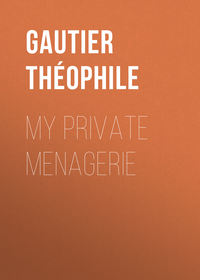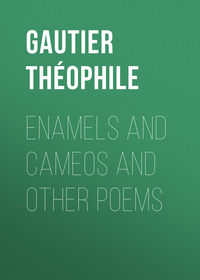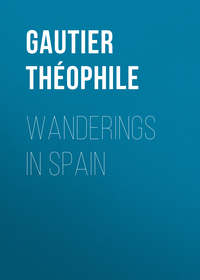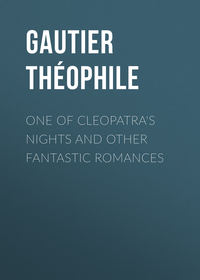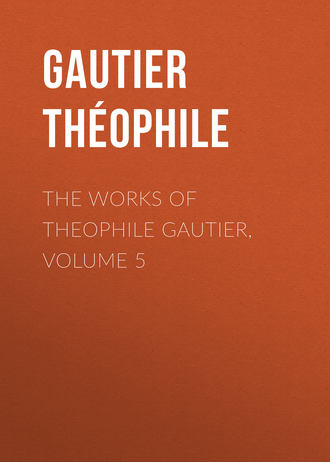 полная версия
полная версияThe Works of Theophile Gautier, Volume 5
"Shall I open the sarcophagus?" said Argyropoulos, after Lord Evandale and Doctor Rumphius had had time to admire the beauty of the Golden Hall.
"Unquestionably," replied the nobleman; "but take care not to chip the edges of the cover as you put in your crow-bars, for I propose to carry off the tomb and present it to the British Museum."
The whole company bent their efforts to displacing the monolith. Wooden wedges were carefully driven in, and presently the huge stone was moved and slid down the props prepared to receive it. The sarcophagus having been opened, showed the first bier hermetically sealed. It was a coffer adorned with paintings and gilding, representing a sort of shrine with symmetrical designs, lozenges, quadrilles, palm leaves, and lines of hieroglyphs. The cover was opened, and Rumphius, who was bending over the sarcophagus, uttered a cry of surprise when he discovered the contents of the coffin, having recognised the sex of the mummy by the absence of the Osiris beard and the shape of the cartonnage. The Greek himself appeared amazed. His long experience in excavations enabled him to understand the strangeness of such a find. The valley of Biban el Molûk contains the tombs of kings only: the necropolis of the queens is situated farther away, in another mountain gorge. The tombs of the queens are very simple, and usually consist of two or three passage-ways and one or two rooms. Women in the East have always been considered as inferior to men, even in death. Most of these tombs, which were broken into at a very distant period, were used as receptacles for shapeless mummies carelessly embalmed, which still exhibit traces of leprosy and elephantiasis. How did this woman's coffin come to occupy this royal sarcophagus, in the centre of this cryptic palace worthy of the most illustrious and most powerful of the Pharaohs?
"This," said the doctor to Lord Evandale, "upsets all my notions and all my theories. It overthrows the system most carefully built upon the Egyptian funeral rites, which nevertheless have been so carefully followed out during thousands of years. No doubt we have come upon some obscure point, some forgotten mystery of history. A woman did ascend the throne of the Pharaohs and did govern Egypt. She was called Tahoser, as we learn from the cartouches engraved upon older inscriptions hammered away. She usurped the tomb as she usurped the throne. Or perhaps some other ambitious woman, of whom history has preserved no trace, renewed her attempt."
"No one is better able to solve this difficult problem than you," said Lord Evandale. "We will carry this box full of secrets to our boat, where you will, at your leisure, decipher this historic document and read the riddle set by these hawks, scarabæi, kneeling figures, serrated lines, winged uræus, and spatula hands, which you read as readily as did the great Champollion."
The fellahs, under the orders of Argyropoulos, carried off the huge coffer on their shoulders, and the mummy, performing in an inverse direction the funeral travel it had accomplished in the days of Moses, in a painted and gilded bari preceded by a long procession, was embarked upon the sandal which had brought the travellers, soon reached the vessel moored on the Nile, and was placed in the cabin, which was not unlike, so little do forms change in Egypt, the shrine of the funeral boat.
Argyropoulos, having arranged about the box all the objects which had been found near it, stood respectfully at the cabin door and appeared to be waiting. Lord Evandale understood, and ordered his valet to pay him the twenty-five thousand francs.
The open bier was placed upon rests in the centre of the cabin; it shone as brilliantly as if the colours had been put on the day before, and framed in the mummy, moulded within its cartonnage, the workmanship of which was remarkably fine and rich. Never had ancient Egypt more carefully wrapped up one of her children for the eternal sleep. Although no shape was indicated by the funeral Hermes, ending in a sheath from which stood out alone the shoulders and the head, one could guess there was under that thick envelope a young and graceful form. The gilded mask, with its long eyes outlined with black and brightened with enamel, the nose with its delicate nostrils, the rounded cheek-bones, the half-open lips smiling with an indescribable, sphinx-like smile, the chin somewhat short in curve but of extreme beauty of contour, presented the purest type of the Egyptian ideal, and testified by a thousand small, characteristic details which art cannot invent, to the individual character of the portrait. Numberless fine plaits of hair, tressed with cords and separated by bandeaux, fell in opulent masses on either side of the face. A lotus stem, springing from the back of the neck, bowed over the head and opened its azure calyx over the dead, cold brow, completing with a funeral cone this rich and elegant head-dress.
A broad necklace, composed of fine enamels cloisonnés with gold and formed of several rows, lay upon the lower portion of the neck, and allowed to be seen the clean, firm contour of two virgin breasts like two golden cups.
The sacred ram-headed bird, bearing between its green horns the red disc of the setting sun and supported by two serpents wearing the pschent and swelling out their hoods, showed on the bosom of the figure its monstrous form full of symbolic meaning. Lower down, in the spaces left free by the crossed zones, and rayed with brilliant colours representing bandages, the vulture of Phra, crowned with a globe, with outspread wings, the body covered with symmetrically arranged feathers, and the tail spread out fanwise, held in its talons the huge Tau, emblem of immortality. The funeral gods, green-faced, with the mouths of monkeys or jackals, held out with a gesture hieratic in its stiffness the whip, the crook, and the sceptre. The eye of Osiris opened its red ball outlined with antimony. Celestial snakes swelled their hoods around the sacred discs; symbolical figures projected their feathered arms; and the two goddesses of the Beginning and the End, their hair powdered with blue dust, bare down to below the breasts and the rest of the body wrapped in a close-fitting skirt, knelt in Egyptian fashion on green and red cushions adorned with heavy tufts.
A longitudinal band of hieroglyphs, springing from the belt and running down to the feet, contained no doubt some formal funeral ritual, or rather, the names and titles of the deceased, a problem which Dr. Rumphius promised himself to solve later.
The character of the drawing, the boldness of the lines, the brilliancy of the colours in all these paintings denoted in the plainest manner to a practised eye that they belonged to the finest period of Egyptian art. When the English nobleman and his companion had sufficiently studied this outer case, they drew the cartonnage from the box and set it up against the side of the cabin, where the funeral form, with its gilded mask, presented a strange spectacle, standing upright like a materialised spectre and with a seeming attitude of life, after having preserved so long the horizontal attitude of death on a basalt bed in the heart of the mountain, opened up by impious curiosity. The soul of the deceased, which had reckoned on eternal rest and which had taken such care to preserve its remains from violation, must have been moved, beyond the worlds, in the circuit of its travels and transmigrations.
Dr. Rumphius, armed with a chisel and a hammer, to separate the two parts of the cartonnage of the mummy, looked like one of those funeral genii which wear a bestial mask and which are seen in the paintings of the hypogea crowding around the dead in the performance of some frightful and mysterious rite; the clean profile of Lord Evandale, calm and attentive, made him look like the divine Osiris awaiting the soul to be judged.
The operation having been at length completed – for the doctor wished not to scale off the gilding, – the box, resting on the ground, was separated into two parts like the casing of a cast, and the mummy appeared in all the brilliancy of its death toilet, coquettishly adorned as if it had wished to charm the genii of the subterranean realms. On opening the case, a faint, delightful, aromatic odour of cedar liquor, of sandal powder, of myrrh and cinnamon spread through the cabin of the vessel; for the body had not been gummed up and hardened with the black bitumen used in embalming the bodies of ordinary persons, and all the skill of the embalmers, the former inhabitants of Memnonia, seemed to have been directed to the preservation of these precious remains.
The head was enveloped in a network of narrow bands of fine linen, through which the face showed faintly. The essences in which they had been steeped had dyed the tissue a beautiful tawny tint. Over the breast a network of fine tubes of blue glass, very like the long jet beads which are used to embroider Spanish bodices, with little golden drops wherever the tubes crossed, fell down to the feet and formed a pearly shroud worthy of a queen. The statuettes of the four gods of Amenti in hammered gold shone brilliantly, and were symmetrically arranged along the upper edge of the network, which ended below in a fringe of most tasteful ornaments. Between the statuettes of the funeral gods was a golden plate, above which a lapis-lazuli scarabæus spread out its long golden wings. Under the mummy's head was placed a rich mirror of polished metal, as if it had been desired to give the dead soul an opportunity of beholding the spectre of its beauty during the long night of the tomb. By the mirror lay a coffer of enamelled ware, of most precious workmanship, which contained a necklace composed of ivory rings alternating with beads, gold, lapis-lazuli, and cornelian. By the side of the beauty had been placed also a narrow, square sandal-wood basin in which, during her lifetime, the dead woman had performed her perfumed ablutions. Three vases of wavy alabaster fastened to the bier, as was also the mummy, by a layer of natron, contained, the first two, essences, the scent of which could still be noticed, and the third, antimony powder and a small spatula for the purpose of colouring the edge of the eyelids and extending the outer angle according to the antique Egyptian usage, still practised at the present time by Eastern women.
"What a touching custom!" said Dr. Rumphius, excited by the sight of these treasures; "what a touching custom it was to bury with a young woman all her pretty toilet articles! For it is a young woman unquestionably that these linen bands, yellow with time and with essences, envelop. Compared with the Egyptians, we are downright barbarians; hurried on by our brutal way of living, we have lost the delicate sense of death. How much tenderness, how much regard, how much love do not these minute cares reveal, these infinite precautions, these useless caresses bestowed upon a senseless body, – that struggle to snatch from destruction an adored form and to restore it intact to the soul on the day of the supreme reunion!"
"Perhaps," replied Lord Evandale, very thoughtful, "our civilisation, which we think so highly developed, is, after all, but a great decadence which has lost even the historical remembrance of the gigantic societies which have disappeared. We are stupidly proud of a few ingenious pieces of mechanism which we have recently invented, and we forget the colossal splendours and the vast works impossible to any other nation, which are found in the ancient land of the Pharaohs. We have steam, but steam is less powerful than the force which built the Pyramids, dug out hypogea, carved mountains into the shapes of sphinxes and obelisks, sealed halls with one great stone which all our engines could not move, cut out monolithic chapels, and saved frail human remains from annihilation, – so deep a sense of eternity did it already possess."
"Oh, the Egyptians," said Dr. Rumphius, smiling, "were wonderful architects, amazing artists, and great scholars. A priest of Memphis and of Thebes could have taught even our German scholars; and as regards symbolism, they were greater than any symbolists of our day. But we shall succeed eventually in deciphering their hieroglyphs and penetrating their mysteries. The great Champollion has made out their alphabet; we shall easily read their granite books. Meanwhile, let us strip, as delicately as possible, this young beauty who is more than three thousand years of age."
"Poor woman!" murmured the young lord. "Profane eyes will now behold the mysterious charms which love itself perhaps never saw. Truly, under the empty pretext of scientific pursuit, we are as barbarous as the Persians of Cambyses, and if I were not afraid of driving to despair this worthy scholar, I should enclose you again, without having stripped off your last veil, within the triple box of your bier."
Dr. Rumphius raised from the casing the mummy, which was no heavier than a child's body, and began to unwrap it with motherly skill and lightness of touch. He first of all undid the outer envelope of linen, sewed together and impregnated with palm wine, and the broad bands which here and there girdled the body. Then he took hold of the end of a thin, narrow band, the infinite windings of which enclosed the limbs of the young Egyptian. He rolled up the band on itself as cleverly as the most skilful embalmer of the City of the Dead, following it up in all its meanderings and circumvolutions. As he progressed in his work, the mummy, freed from its envelope, like a statue which a sculptor blocks out of the marble, appeared more slender and exquisite in form. The bandage having been unrolled, another narrower one was seen, intended to bind the body more closely. It was of such fine linen, and so finely woven, that it was comparable to modern cambric and muslin. This bandage followed accurately every outline, imprisoning the fingers and the toes, moulding like a mask the features of the face, which was visible through the thin tissue. The aromatic balm in which it had been steeped had stiffened it, and as it came away under the fingers of the doctor, it gave out a little dry sound like that of paper that is being crushed or torn. There remained but one turn to be taken off, and familiar though he was with such work, Dr. Rumphius stopped for a moment, either through respect for the dead, or through that feeling which prevents a man from breaking open a letter, from opening a door, from raising a veil which hides a secret that he burns to learn. He ascribed his momentary pause to fatigue, and as a matter of fact, the perspiration was dripping from his forehead without his thinking of wiping it with his great blue-checked handkerchief; but fatigue had nothing to do with it. Meanwhile the dead form showed through the fine, gauze-like stuff, and some gold work shone faintly through it as well.
The last wrapping taken off, the young woman showed in the chaste nudity of her lovely form, preserving, in spite of so many centuries that had passed away, the fulness of her contours, and the easy grace of her pure lines. Her pose, an infrequent one in the case of mummies, was that of the Venus of Medici, as if the embalmers had wished to save this beautiful body from the set attitude of death and to soften the inflexible rigidity of the cadaver.
A cry of admiration was uttered at the same time by Rumphius and Evandale at the sight of the marvel. Never did a Greek or Roman statue present a more beautiful appearance. The peculiar characteristics of the Egyptian ideal gave indeed to this lovely body, so miraculously preserved, a slenderness and a grace lacking in antique marbles, – the long hands, the high-bred, narrow feet, the nails shining like agate, the slender waist, the shape of the breasts, small and turned up like a sandal beneath the veil which enveloped it, the slightly protruding contour of the hip, the roundness of the thigh, the somewhat long leg recalling the slender grace of the musicians and dancers represented on the frescoes of funeral repasts in the Thebes hypogea. It was a shape still childish in its gracefulness, yet possessing already all the perfections of a woman which Egyptian art expresses with such tender suavity, whether it paints the walls of the passages with a brush, or whether it patiently carves the hard basalt.
As a general rule mummies which have been filled with bitumen and natron resemble black simulacra carved in ebony; corruption cannot attack them, but the appearance of life is wholly lacking; the bodies have not returned to the dust whence they came, but they have been petrified in a hideous shape, which one cannot contemplate without disgust and terror. In this case, the body, carefully prepared by surer, longer, and more costly processes, had preserved the elasticity of the flesh, the grain of the skin, and almost its natural colour. The skin, of a light brown, had the golden tint of a new Florentine bronze, and the amber, warm tone which is admired in the paintings of Giorgione and Titian covered with a smoky varnish, was not very different from what must have been the complexion of the young Egyptian during her lifetime. She seemed to be asleep rather than dead. The eyelids, still fringed with their long lashes, allowed eyes lustrous with the humid gleam of life to shine between their lines of antimony. One could have sworn they were about to shake off, as a light dream, their sleep of thirty centuries. The nose, delicate and fine, preserved its pure outline; no depression deformed the cheeks, which were as round as the side of a vase; the mouth, coloured with a faint blush, had preserved its imperceptible lines, and on the lips, voluptuously moulded, fluttered a melancholy and mysterious smile, full of gentleness, sadness, and charm, – that tender and resigned smile which pouts so prettily the lips of the adorable heads which surmount the Canopean vases in the Louvre.
Around the forehead, low and smooth in accordance with the laws of antique beauty, was massed jet-black hair divided and plaited into a multitude of fine tresses which fell on either shoulder. Twenty golden pins stuck into the tresses, like flowers in a ball head-dress, studded with brilliant points the thick dark hair which might have been thought artificial, so abundant was it. Two great earrings, round discs resembling small bucklers, shimmered with yellow light by the side of the brown cheeks. A magnificent necklace, composed of three rows of divinities and amulets in gold and precious stones, encircled the neck of the coquettish mummy, and lower down upon her breast hung two other collars, the pearl, gold, lapis-lazuli, and cornelian rosettes of which alternated symmetrically with the most perfect taste. A girdle of nearly the same design enclosed her waist with a belt of gold and gems. A double bracelet of gold and cornelian beads adorned her left wrist, and on the index of the left hand shone a very small scarabæus of golden cloisonné enamel, which formed a seal ring and was held by a gold thread most marvellously plaited.
Strange were the sensations of the two men as they found themselves face to face with a human being who had lived in the days when history was yet young and was collecting the stories told by tradition; face to face with a body contemporary with Moses, which yet preserved the exquisite form of youth; as they touched the gentle little hand impregnated with perfumes, which a Pharaoh perhaps had kissed; as they fingered the hair, more durable than empire, more solid than granite monuments. At the sight of the lovely dead girl, the young nobleman felt the retrospective desire often inspired by the sight of a statue or a painting representing a woman of past days famous for her beauty. It seemed to him that he would have loved, had he lived three thousand years earlier, that beauty which nothingness had refused to destroy; and the sympathetic thought perhaps reached the restless soul that fluttered above its profaned frame.
Far less poetic than the young nobleman, Dr. Rumphius was making the inventory of the gems, without, however, taking them off; for Evandale had ordered that the mummy should not be deprived of this last frail consolation. To take away gems from a woman, even dead, is to kill her a second time. Suddenly a papyrus roll concealed between the side and arm of the mummy caught the doctor's eye.
"Oh!" said he, "this is no doubt a copy of the funeral ritual placed in the inner coffin and written with more or less care according to the wealth and rank of the person."
He unrolled the delicate band with infinite precautions. As soon as the first lines showed, he exhibited surprise, for he did not recognise the ordinary figures and signs of the ritual. In vain he sought in the usual places for the vignettes representing the funeral, which serve as a frontispiece to such papyri, nor did he find the Litany of the Hundred Names of Osiris, nor the soul's passport, nor the petition to the gods of Amenti. Drawings of a peculiar kind illustrated entirely different scenes connected with human life, and not with the voyage of the shade to the world beyond. Chapters and paragraphs seemed to be indicated by characters written in red, evidently for the purpose of distinguishing them from the remainder of the text, which was in black, and of calling the attention of the reader to interesting points. An inscription placed at the head appeared to contain the title of the work, and the name of the grammat who had written or copied it, – so much, at least, did the sagacious intuition of the doctor make out at the first glance.
"Undoubtedly, my lord, we have robbed Master Argyropoulos," said he to Evandale, as he pointed out the differences between the papyrus and the usual ritual. "This is the first time that an Egyptian manuscript has been found to contain anything else than hieratic formulæ. I am bound to decipher it, even if it costs me my sight, even if my beard grows thrice around my desk. Yes, I shall ferret out your secret, mysterious Egypt! Yes, I shall learn your story, you lovely dead; for that papyrus pressed close to your heart by your lovely arm surely contains it. And I shall be covered with glory, become the equal of Champollion, and make Lepsius die of jealousy."
The nobleman and the doctor returned to Europe. The mummy, wrapped up again in all its bandages and replaced within its three cases, rests within Lord Evandale's park in Lincolnshire, in the basalt sarcophagus which he brought at great expense from Biban el Molûk and which he did not give to the British Museum. Sometimes Lord Evandale leans upon the sarcophagus, sinks into a deep reverie, and sighs.
After three years of unflagging application, Dr. Rumphius succeeded in deciphering the mysterious papyrus, save in some damaged parts, and in others which contained unknown signs. And it is his translation into Latin – which we have turned into French – that you are about to read, under the name, "The Romance of a Mummy."
I
Oph (that is the name of the city which antiquity called Thebes of the Hundred Gates, or Diospolis Magna), seemed asleep under the burning beams of the blazing sun. It was noon. A white light fell from the pale sky upon the baked earth; the sand, shimmering and scintillating, shone like burnished metal; shadows there were none, save a narrow, bluish line at the foot of buildings, like the inky line with which an architect draws upon papyrus; the houses, whose walls sloped well inwards, glowed like bricks in an oven; every door was closed, and no one showed at the windows, which were closed with blinds of reeds.
At the end of the deserted streets and above the terraces stood out in the hot, transparent air the tips of obelisks, the tops of pylons, the entablatures of palaces and temples, whose capitals, formed of human faces or lotus flowers, showed partially, breaking the horizontal lines of the roofs and rising like reefs amid the mass of private buildings. Here and there above a garden wall shot up the scaly trunk of a palm tree ending in a plume of leaves, not one of which stirred, for never a breath blew. Acacias, mimosas, and Pharaoh fig-trees formed a cascade of foliage that cast a narrow blue shadow upon the dazzling brilliancy of the ground. These green spots refreshed and enlivened the solemn aridity of the picture, which but for them would have been that of a dead city.
A few slaves of the Nahasi race, black complexioned, monkey-faced, with bestial gait, alone braving the heat of the day, were bearing to their masters' homes the water drawn from the Nile in jars that were hung from a stick placed on their shoulder. Although they wore nothing but striped drawers wrinkling on their hips, their torsos, brilliant and polished like basalt, streamed with perspiration as they quickened their pace lest they should scorch the thick soles of their feet on the pavements, which were as hot as the floor of a vapour bath. The boatmen were asleep in the cabins of their boats moored to the brick wall of the river quay, sure that no one would waken them to cross to the other bank, where lay the Memnonia quarter. In the highest heaven wheeled vultures, whose shrill call, that at any other time would have been lost in the rumour of the city, could be plainly heard in the general silence. On the cornices of the monuments two or three ibises, one leg drawn up under their body, their long bill resting on their breast, seemed to be meditating deeply, and stood out against the calcined, whitish blue which formed the background.


